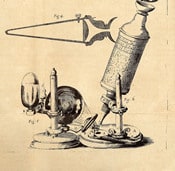“The Most Ingenious Book that I Ever Read in My Life” – Samuel Pepys
Robert Hooke (1635-1703). Micrographia: or, Some physiological descriptions of minute bodies made by magnifying glasses. London: J. Martyn and J. Allestry, 1665.
 In 1665, Robert Hooke completed one of the most remarkable books of the last four centuries: a collection of drawings and descriptions of everyday objects as viewed through the lenses of a compound microscope. Hooke was curator of experiments for the newly formed Royal Society of London whose membership included the likes of Isaac Newton, Robert Boyle, Christopher Wren, and Thomas Willis; the book was published under the aegis of the Society.
In 1665, Robert Hooke completed one of the most remarkable books of the last four centuries: a collection of drawings and descriptions of everyday objects as viewed through the lenses of a compound microscope. Hooke was curator of experiments for the newly formed Royal Society of London whose membership included the likes of Isaac Newton, Robert Boyle, Christopher Wren, and Thomas Willis; the book was published under the aegis of the Society.
 Although Micrographia was not the first work to include microscopic illustrations, it was the first to provide them in quantity and rendered in such meticulous fashion. So accurate were the drawings that a few of them continued to be reprinted in textbooks for the next 200 years! The exquisite copper-plate engravings along with Hooke’s fascinating commentary made the book an instant best-seller among Europe’s intelligentsia. On January 21st, Samuel Pepys, himself an early member of the Royal Soceity, made the following entry in his diary: “Before I went to bed I sat up till two o’clock in my chamber reading of Mr. Hooke’s Microscopicall Observations, the most ingenious book that ever I read in my life.”
Although Micrographia was not the first work to include microscopic illustrations, it was the first to provide them in quantity and rendered in such meticulous fashion. So accurate were the drawings that a few of them continued to be reprinted in textbooks for the next 200 years! The exquisite copper-plate engravings along with Hooke’s fascinating commentary made the book an instant best-seller among Europe’s intelligentsia. On January 21st, Samuel Pepys, himself an early member of the Royal Soceity, made the following entry in his diary: “Before I went to bed I sat up till two o’clock in my chamber reading of Mr. Hooke’s Microscopicall Observations, the most ingenious book that ever I read in my life.”
Micrographia was one of a myriad of accomplishments wrought by Robert Hooke who distinguished himself in physics, medicine, architecture, chemistry, and oceanography. With the possible exception of Isaac Newton, he was the greatest scientist of the 17th century.